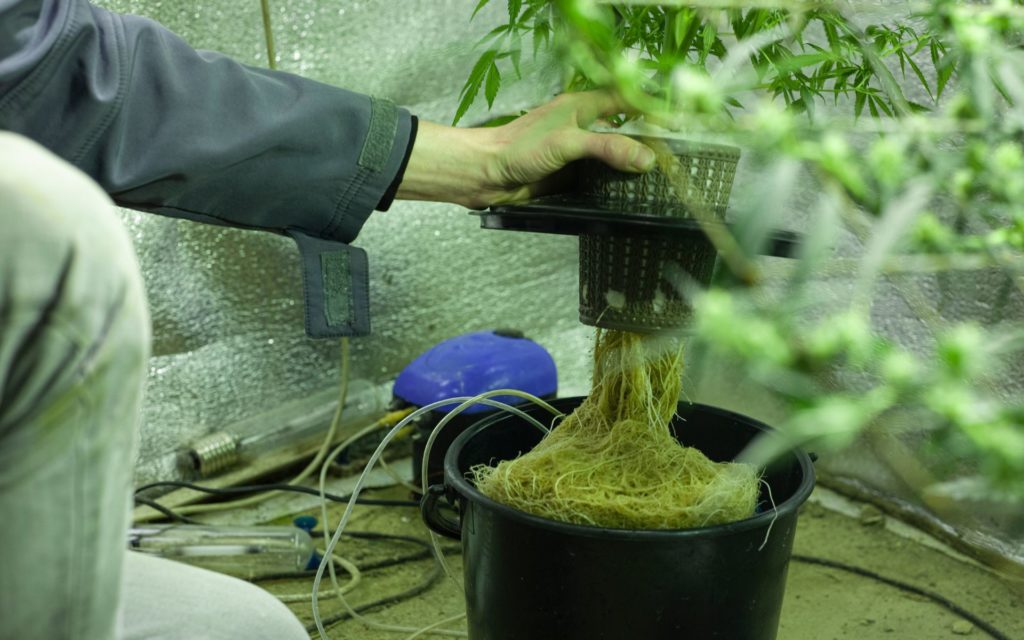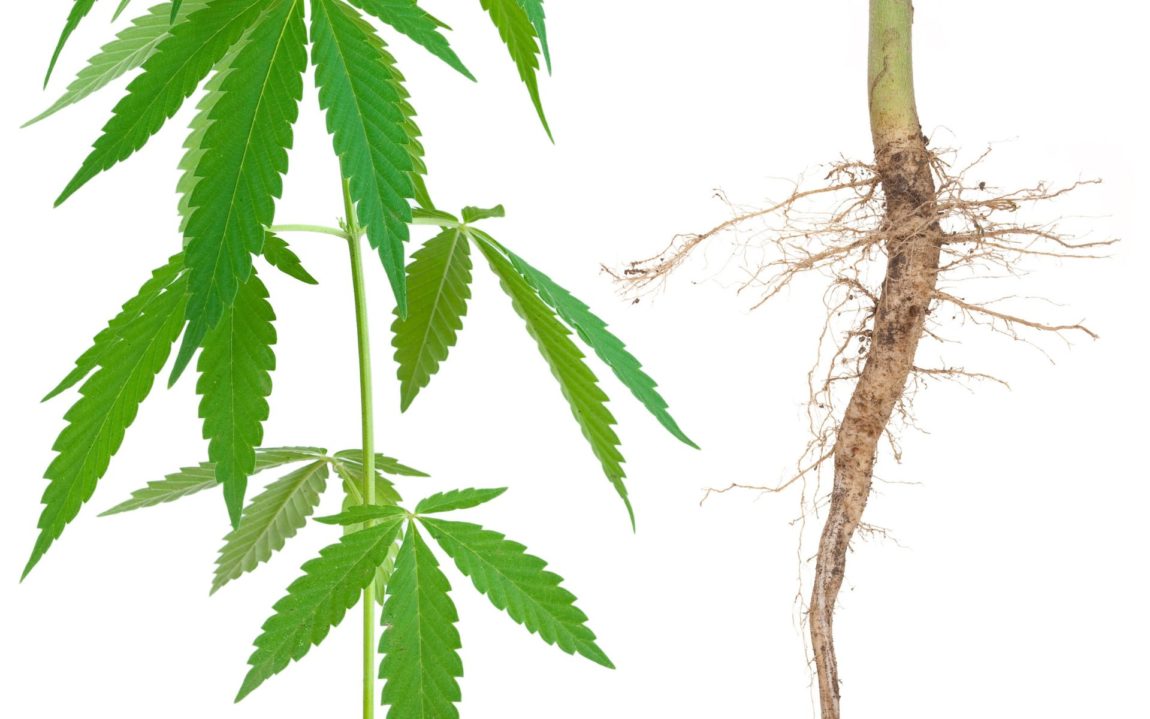While cannabinoids like THC and CBD drive the attention around cannabis, the plant is highly diverse, and every part can be utilized. Cannabis roots are especially beneficial with various uses supporting a holistic lifestyle.
In this post, we will take our attention away from the flowers and focus on the roots. We highlight 10 interesting facts that will give you a better understanding of one of the most neglected aspects of cannabis plants.
What are Cannabis Roots?
Cannabis roots are an essential part of the plant, providing support and absorbing water and nutrients from the soil to ensure healthy buds and green leaves. The roots also help to anchor the plant in place, preventing it from being blown over by the wind or washed away by rain.
Cannabis roots typically grow to a depth of around 2-3 feet, but they can reach up to 6 feet in some cases. The main root is usually white or light-colored, while the smaller lateral roots are often darker.
When growing cannabis, it is important to provide the roots with plenty of space to spread out. This can be done by using a container that is at least 12 inches deep, or by planting the plant in a raised bed.
Roots need oxygen to survive, so it is also important to make sure that the soil is loose and well-aerated. With proper care, cannabis roots can grow to be very sturdy and resilient, providing a strong foundation for a healthy plant.
10 Interesting Facts About Cannabis Roots
Below are 10 of the most interesting facts about cannabis roots that will make you think twice about discarding the fundamental component of the plant.
1-Used for Medicinal Purposes for Centuries
Cannabis roots have been used for medicinal purposes for centuries by cultures all around the world.
Traditional Chinese medicine used roots from various plants, including cannabis, to treat a wide variety of ailments, including pain, and inflammation.
History also shows that cannabis roots were used in ancient Greece and Rome to treat a wide variety of conditions, including gout, toothache, and even earache.
In most recent history, medicinal roots were used in the United States during the Civil War to make a tincture that was used to treat pain and anxiety.
2-Rich Source of Vitamins and Minerals
The cannabis plant contains a wide variety of vitamins and minerals that are essential to human health, and these nutrients are found in abundance in the roots.
Some of the most notable nutrients include vitamin C, calcium, magnesium, phosphorus, and even potassium.
Cannabis roots also contain a wide variety of antioxidants that can help protect the body from damage caused by free radicals.
 3-Easy to Grow and Harvest
3-Easy to Grow and Harvest
Cannabis roots are extremely easy to grow, hence the decades-old nickname ‘weed.’ While premium cannabis high in cannabinoids is difficult to cultivate, developing a complex root system doesn’t require the same controlled environment as a flower.
This makes cannabis an ideal plant for those looking to get into horticulture without a lot of experience or expensive equipment.
4-Can Be Eaten Raw or Cooked
Cannabis roots have been consumed in various ways throughout history. They can be eaten raw, boiled, dried, mixed with butter, ground into powder, and combined with juice to form a pasty substance.
In their raw form, cannabis roots have a crunchy texture and a slightly sweet flavor. When cooked, they take on a more starchy taste and can be used in many different recipes.
If you prefer a sweeter taste, you can also candy cannabis roots and store them in jars as a naturally sweet treat.
5-Cannabis Roots have a Sweet, Nutty Flavor
Terpenes are the driving factor in a plant’s taste and aroma. In addition, aromatic oils are essential for evolution and deliver various health benefits.
Cannabis roots contain a variety of terpenes that give them a sweet, nutty flavor. Depending on the plant, the roots can also have hints of citrus, mint, or even lavender.
Their subtle flavor makes them a perfect addition to many different types of recipes, from smoothies and juices to soups and stews.
6-High in Antioxidants
Numerous parts of the cannabis plant are well known for having antioxidant properties. Cannabis roots also have this quality due to a high concentration of pentacyclic triterpenoids.
According to Science Direct, “Naturally occurring triterpenoids are described as being of therapeutic value because of their anti-cancer, anti-inflammatory, antiulcerogenic or antiviral activities.”
The same pentacyclic triterpenoids can also be found in other plants such as ginseng, goji berries, and even certain mushrooms.
7-Help with Detox
Cannabis roots have properties that improve gastrointestinal activity. Many holistic medicine advocates mix the roots with other plants like chamomile and elderberry in boiling water to make a natural detox tea.
A scientific journal article published in the NCBI reports natives from Chile and Argentina use cannabis roots to reduce nausea, induce vomiting, reduce stomach pain, and remove toxins and infections from the digestive tract.
8-Boost the Immune System
The role of cannabis and the immune system is controversial, especially after COVID-19. Misinformation was abundant online related to cannabinoids, boosting the immune system, or even treating the novel coronavirus. While there have been studies to suggest CBD has the potential to heal autoimmune diseases, smoking is one of the fastest ways to harm your immune system.
While the role of cannabinoids and the immune system is complicated, cannabis roots don’t contain the compound. Experts believe that the triterpene content in cannabis roots, depending on the species, can lead to improving the immune response when consumed regularly.
A Pub Med meta-analysis explores the immune system-boosting properties of triterpenes. The article states that the diverse compounds have the ‘mechanisms of action of many of the medicinal plants used to fight diseases that attack the immune system.
 9-Relive Pain and Inflammation
9-Relive Pain and Inflammation
Pain relief is the most common medicinal use for cannabis roots. They’ve been used orally and topically to treat various ailments, including joint pain, gout, arthritis, cramps, hard tumors, and sciatica.
Physicians and botanists throughout history are recorded using cannabis roots as one of their go-to remedies. For example, in 1640, English botanist and herbalist John Parkinson wrote;
“…the decoction of the rootes, easeth the paines of the goute, the hard tumours, or knots of the joynts, the paines and shrinking of the sinewes, and other the like paines of the hippes.”
The cannabis roots’ ability to reduce inflammation has also been widely referenced in books and medical journals. A decoction of the root taken orally or topically is mentioned in the following according to an article in the NIH:
- Culpeper’s Complete Herbal by Nicholas Culpeper – English botanist, herbalist, physician
- Pharmacopoeia Universalis: or, A New Universal English Dispensatory by Rober James – Enligh physicianMakhzan-al-Adwiya by M. Husain Khan – Persian medical author
10-Can Be Made Into Tea and Tinctures
All through history, people have been using cannabis roots to make tea and tinctures. This is an excellent way to extract the plant’s medicinal properties and enjoy them in a delicious and easy-to-consume beverage.
Cannabis root tea has a slightly sweet taste and can be enjoyed hot or cold. It’s also incredibly easy to make, requiring only a few minutes of preparation time.
Ancient cultures used cannabis root tea to treat a wide variety of ailments, including pain, inflammation, anxiety, and even headaches.
Conclusion
Cannabis roots are accepted as an essential part of a plant’s development but are rarely consumed. It’s easy to overlook the roots when the flowers produce precious resin glands, and the biomass has thousands of industrial applications.
Next harvest, instead of throwing away your cannabis roots, you may want to consider saving and putting the natural healing properties to good use in a tea or smoothy.





No Comments